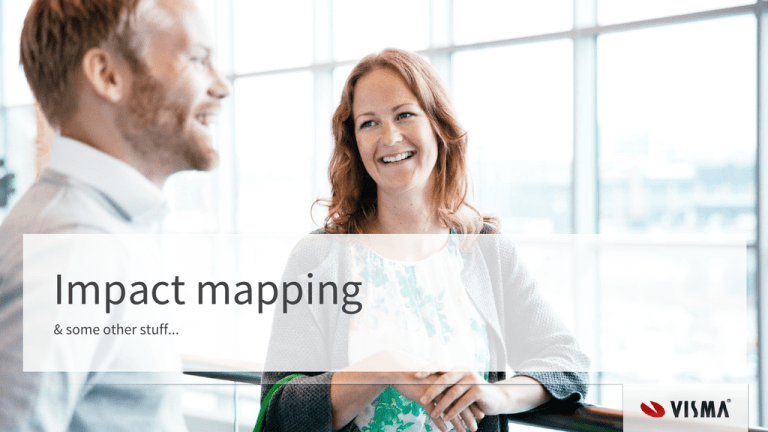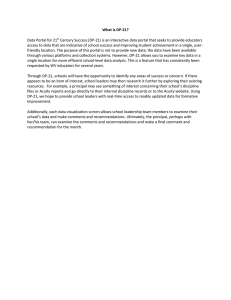Impact mapping & some other stuff...
advertisement

Impact mapping & some other stuff... Facts about Visma Philosophy: We keep our customers one step ahead We work towards: Providing IT solutions that keep our customers one step ahead of their competition ● ● ● ● ● ● ● Innovation: 18% of total revenues are reinvested in R&D Ca 7 000 employees Ca 400 000 customers Hosting services for 330 000 customers Headquarter in Oslo, Norway Ambition to grow by acquisitions We are always improving the way we work The UX role at Visma Adzic’s Impact map How big, and what type of effort, is the user prepared to invest when using our mobile portal? How should the mobile portal be designed in order to give as much value as possible to the customer as well as to us? effort benefit What value does the user want to gain from his/her usage of the mobile portal? What effects do we expect to see when the mobile portal is in use? effect investment How big investments should we make in the service? Design brief Why? • Why are we carrying out this project? • What should the finished product/service give back to our business/operation? • What effects can we expect to get from the finished product/service once it is used? Examples of effect goals (high level) • The online orders increase by 25% after redesign of webshop • Calls to customer support decrease by 40% after introduction of the new process • Awareness of our brand is raised by 5% in our primary segment “stay at home dads” Effect goals are not... ● Product goals ○ The system should have a search function ○ The average response time should not exceed 5 seconds ● Project goals ○ The project shall be carried out on time and within budget Breaking down effect goals ● ● Sub goals and effects ○ How? (downward in your map) ○ Why? (upward in your map) Overall goal/vision Subgoal Success metrics ○ How should we measure success? ■ What do we measure? ■ When do we measure (milestones and frequency)? ■ How do we measure? Subgoal Subgoal Who? • Who will, by using our product, bring us the effects we want? • What are the specific characteristics of our target customers/users? • Where do we find them? • How do we communicate with them? • Do we already know them? • Are there different target groups? effort benefit What value does the user want to gain from his/her usage of the service? effect investment Segmentation Design criteria - high level • • Design goal • What have you learned about the target customer? • What needs (functional, emotional, psychological, social) does the design have to fulfill for the target customer? • Why is it strategically important for your organization to address those needs? User perceptions • How important is your proposed offering to the target customer’s well-being? • Are there aesthetic attributes necessary to succeed with the target customer? • Does the target customer expect the offering to have certain social, ethical , or ecological attributes? How? • How should the customers/users behaviour change? • How can our customers/users help us to achieve the goal? • How can our customer/users hinder us in achieving the goal? • Examples: • Inviting more friends • Purchasing tickets without calling the call center • Selling tickets faster Current behaviour Wanted behaviour What? • What can we do to support the required effects? • What should we deliver to the customers/users? • Place every feature/function in the context of the effect that it is supposed to support • Examples: • Online ticket sales • Mobile home page with purchase form • Optimise call centre sales scripts • Sign re-selling contracts Design criteria - low level • • • Physical attributes • Must the offering be able to capture, store, and/or transmit information about usage? • Does the offering need to be designed for use in specific environments or situations? • Are there weight or size considerations for lifting, use or transport? • Are there memory, bandwidth, or connectivity issues? Functional attributes • Does the design of the offering need to accommodate specific use-case scenarios? List them in order of importance to the target customer. • Does the design need to address compatibility or standards issues? Constraints • Does the final offering need to be completed by a specific date? • What constraints does your current business impose (the offering must use the existing manufacturing base, provide higher profit margins than current offerings, leverage proprietary technologies, etc)? • Are there ecosystems and regulatory concerns (height of shelves at retailers, regulations, etc)? Questions? Example - The Purchasing Portal Overall business goals Effect goals for redesigned portal Ideal target customer segmentation work Quantitative data CRM NPS data User research fieldwork Insights for design Effect goals for the purchase portal ● ● ● ● ● Workshop with management Top-down: how should we help in reaching Visma’s vision? Bottom-up: what problems do we want to solve in the new version of the portal? Worked iteratively to meet in the middle Examples: ○ Decreased level of regrets in all customer segments 3 months after signing the agreement ■ Measurements: Increased payment frequency by 5% and less usage of safety guarantee by 3% Finding the Ideal Target Customer The customer and his company Unclear areas of responsabilities Family business Name: Bengt Flat organisation Role: Purchasing manager Background: Engineer What is the customer like? Orderly & finicky Knowled gable of prices Greedy What are the company’s circumstances? Geographic ally distant Pressured field of business Old in the business Small turnaround Situation Omsättning Turn around Small The business Big Existerande kontrakt Existing contract None Many Typ av område Type of area Safe Unsafe Antal anställda Number of employees The customer as an individual 0 > 50 Behov av support Interest in statistics Small Big Teknikintresse Interest in technology Big Small Intresse/behov av statistik Interest in statistics Small Big Who: • • • • demands the most support? is most likely to leave their contract after 3 months? is most likely to activate most agreements? is most likely to spend the most money on agreements? Quantitative data & analysis • Reports in Sugar CRM • How many ideal target customers do we have? • What do they have in common? • Who are close to them? Who can we help turn into an ideal target customer? • Analysis of NPS survey results • What are the main pain points for our customers? User research in the field Bernt och Karin in! Insights for design Managing and measuring change • Strategic Action Points (SAP) for all divisions include to enhance the customer journey through the full Visma Advantage offering • Measurement points are based on customer satisfaction and loyalty • Actions and milestones include: • everyone shall participate in customer observations and interviews • Key Performance Indicators (KPI:s) include: • increase the customer satisfaction in NPS surveys by 10% Thank you! Läser och agerar på reklamblad Använder bil för att ta sig till affären (känslig för p-avgift) Har gott om tid. Uppskattar kringtjänster. Vill göra klipp. Handlar inte annars. Provar gärna nya saker. Särskilt om det är gratis. Vill ha personlig support. Vill att butiken har koll på hans erbjudanden och rabatter Är priskänslig, vill göra klipp, annars handlar han inte. Är aktiv på sociala medier och säger vad han tycker.




